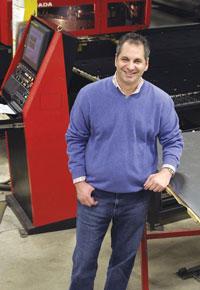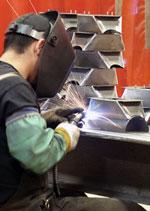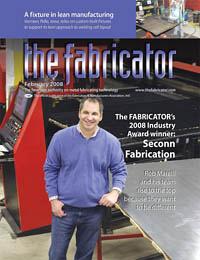Editor-in-Chief
- FMA
- The Fabricator
- FABTECH
- Canadian Metalworking
Categories
- Additive Manufacturing
- Aluminum Welding
- Arc Welding
- Assembly and Joining
- Automation and Robotics
- Bending and Forming
- Consumables
- Cutting and Weld Prep
- Electric Vehicles
- En Español
- Finishing
- Hydroforming
- Laser Cutting
- Laser Welding
- Machining
- Manufacturing Software
- Materials Handling
- Metals/Materials
- Oxyfuel Cutting
- Plasma Cutting
- Power Tools
- Punching and Other Holemaking
- Roll Forming
- Safety
- Sawing
- Shearing
- Shop Management
- Testing and Measuring
- Tube and Pipe Fabrication
- Tube and Pipe Production
- Waterjet Cutting
Industry Directory
Webcasts
Podcasts
FAB 40
Advertise
Subscribe
Account Login
Search
Nothing standard about this fab shop
The old approach isn't of interest to the new kid on the block, Seconn Fabrication—The FABRICATOR's 2008 Industry Award winner
- By Dan Davis
- February 12, 2008
- Article
- Shop Management
After five years of working for a family-owned metal fabricating business in eastern Connecticut, Rob Marelli wanted to do things his way. He approached the president with an offer to buy the company from him, but he was soon gone with a handshake and a letter of recommendation.
He eyed 5,000 square feet of rental space down the road and began thinking about starting his own fabricating business. Soon five top employees—the production manager, the laser cutting machine operator, the estimator, the lead fabricator, and the equipment programmer—from Marelli's old company wanted to join his new mission. Seconn Fabrication opened for business in July 2003.
Some of the nearby old-guard fabricators weren't too impressed. Before Marelli committed to establishing his own shop, he inquired about purchasing a small shop in southeastern Connecticut. The owner replied, "Who the f*** does Rob Marelli think he is?"
"Looking back, it was scary," Marelli recalled. "You would have loved to walk into a building and have all of your equipment and tools there and all of your employees trained. But I really think that we had a clean slate where we could set up our operations and culture the way we wanted to in the beginning. It made a significant difference."
Today Seconn Fabrication and its 66 employees operate out of a 35,000-sq.-ft. facility in Waterford. The company had a record year in 2007, topping $9.5 million, and has broken ground on a 24,000-sq.-ft. expansion this year to double its manufacturing space. The expansion will accommodate an additional powder coating line, an automated laser cutting cell, and a prototyping department.
Meanwhile, the shop owner who wondered just who Rob Marelli was came by in late 2007 to apologize for his gruff remark almost five years earlier and offer his congratulations on Seconn's success.
The FABRICATOR staff and industry experts felt the same way in naming Seconn Fabrication as the recipient of its first Industry Award. (For specifics on contest criteria, please see "Determining the Award Winner.") In only five years the company has managed to achieve success for which many other, older companies still strive. Through employee commitment, investment in technology and people, and focus on meeting customer needs, Seconn Fabrication has laid a foundation for future success.
'Time Clocks Meant Nothing'
With 5,000 sq. ft., Seconn Fabrication got down to business in the summer of 2003. The company bought a used TRUMPF 2530 laser from a competitor. A welding supply shop offered the team credit and gave them a gas metal arc welding (GMAW) power source and related equipment. A steel distributor Marelli knew opened up a line of credit for the new company. Quotes were sent out on a Microsoft Excel spreadsheet. Everyone worked for less than they had in recent years. (In fact, 35 of the first 40 employees came to Seconn for less money than they were previously making, according to Marelli.)
With the used equipment, good credit terms, and competitive labor costs, Seconn Fabrication was competitive from the start on a price-per-job basis. The commitment to turning the jobs around as quickly as possible without sacrificing quality kept the customers coming back.
"No excuses. Time clocks meant nothing," Marelli said. "There was a lot of ownership and fire in their bellies."
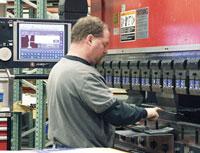
Press brake operators can program a bending job at the machine, but they also can do the job from the front office by using Amada's BendCAM software.
And creativity.
"We had a visit from a company in Long Island, and they asked if we had a conference room that we could sit in. As quickly as I could I said, 'No. There are no walls in this place. We are all part of the same team. We can speak freely here,'" Marelli said. "I didn't have room for a conference room, so here we are at a table in the middle of the shop."
Seconn didn't get that job, but they got others. After six months, the company had accomplished $750,000 in sales, the second-year goal established in the original business plan. By the end of 2004, the company had reached $3.5 million in sales.
Soon employee salaries and wages met industry norms and surpassed them with bonuses. Medical coverage and other benefits were extended. The new kid on the block looked like it wasn't going anywhere for a while.
"My goal was to field the best team," Marelli said. "I don't want to manage it or micromanage it. I want to put the guys in that can make intelligent manufacturing decisions on-the-fly."
Marelli, the company's president as well as owner, said he once saw a PricewaterhouseCoopers study that said a well-incentivized manufacturing company could generate $13,000 to $14,000 in monthly sales per employee. By 2005 the company was producing more than $19,000 in monthly sales per employee.
"The guys just went at it," he said. "There was so much pride and ownership in here with the employees."
Seconn Fabrication moved to its current location in 2006. Even with the relocation and market expansion, the company has been able to maintain the momentum it had in those early years. Here are some of the ways it has done so.
Keeping the Customer First
"Anybody can buy price," Marelli said. "My objective is that I want to do business with a group of people and help them learn that there is a difference between price and cost."
To earn the loyalty that's needed for people to look past just the price, Seconn Fabrication is trying to overwhelm the customer with service. Estimators look to return quotes in 24 hours, and average turnaround time for jobs is nine days. The company bills itself as a one-stop shop for fabricating, machining, and powder coating services and promotes its live customer service available every weekday from 6 a.m. to 6 p.m.
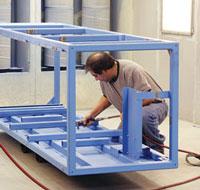
To complement its powder coating line with a three-stage pretreatment system and manual spray booth, Seconn Fabrication purchased a booth for finishing small batches of larger fabrications.
More customer service offerings are on the horizon. The company is looking at establishing a prototyping cell to offer quicker response and take the smaller jobs that slow up throughput of larger-volume jobs on the shop floor. Marelli wants to commence monthly meetings with Seconn Fabrication's engineering team and customers to reconfigure fabrications that could be made more efficiently. There is talk of initiating vendor-managed inventory programs in which Seconn will maintain inventory at customer sites and not charge them for the fabricated parts until they are pulled from the shelves.
"Rob's plan in the future is to allow customers that we want to connect into the [material resource planning] system and see where their parts are—and maybe even change the date," said Richard Sweet, Seconn Fabrication's production manager.
"The system will report where the part is, how much time is left [before delivery], and even provide a Gantt chart, if needed," said Paul Brax, a member of Seconn's production team.
The customer relationship management module that will allow a customer to have visibility into Seconn Fabrication's operations isn't live yet, but it is a logical extension of the company's information technology base. The management team relies heavily on the shop management software package from Exact JobBOSS to keep track of the 86,000 fabricated pieces that go through the shop monthly.
In addition to offering quoting, quality control, and shipping control, the software provides the details to track two very important statistics: production efficiency and on-time delivery. Seconn Fabrication relies on a "working standard"—determined by multiplying productivity (billable hours versus payroll hours) by efficiency (time it took to complete the job after being compared to the time that was quoted)—to see where they stand in terms of getting product out the door to customers. The goal is to have a working standard above 80 percent, and as of late 2007, the company was at 82 percent. That efficiency has translated into an on-time delivery rate of 95 percent.
When it comes to scheduling jobs, Sweet and Brax said they aim to fill about 80 percent to 85 percent of shop floor capacity for the first two weeks of the month and then, like other job shops, watch production capacity reach higher levels as everyone pulls together to complete the rush of jobs that comes at month's end. By watching the working standards of different fabricating cells, production management knows that when levels reach 100 percent or above, they might want to throw extra labor into that area to help or farm out the work to a subcontractor.
To help production management absorb all this information, all the team members in the front office have two computer screens before them, where they can track multiple metrics without having to switch back and forth.
"It's all about speed," Brax said. "How do you get the speed? Find the right people and have the commitment, IT, and tools."
Leaning on Lean Concepts
Applying lean concepts has helped the company to maintain the quick turnaround on jobs. In most instances, the ideas are more common sense than revolutionary.
For example, the job orders that the shop management software creates go into color-coded router packages. If someone on the shop floor sees a red package, he or she recognizes it as a project that's fairly complex. An orange package is one that is less complex, and black represents a fairly straightforward job.
Blue packages, however, stand out as the most sensitive. Only team leaders or supervisors oversee the work done on these jobs. They usually are very time-sensitive or related to a new customer.
The routing packages also contain a form that can be used by the shop floor to share comments with estimators. If production personnel see a big discrepancy with quoted work time for a job or want to make other notes, they jot it down on the form, and the notes are taken back to the estimator. The estimator can take the suggestion under advisement and make changes to the quoting template if necessary.
That feedback contributes to solid job quotes. Sweet estimated the company wins about 60 percent of the 500 to 600 new business quotes sent out each month.
The lean approach also influences shop floor layout:
- Electrical outlets are strategically placed throughout the facility, so workcells can be created quickly with the use of pigtail electrical connections and equipment on casters, such as the Haeger hardware insertion machines.
- Point-of-use material racks are close to machines, so operators don't have to search for parts or equipment.
- Some of those racks near the welding cells have bins that are organized by the job numbers of recurring jobs. When a welder has one of those jobs, he can go to the bin and find all of the parts necessary to complete the welding assignment.
- Extension cords and air hoses on self-winding reels help to keep work areas free of clutter. In the welding cells, wire-feed machines are on booms for the same reason.
- Clean carts are kept near each workstation. The final 15 to 20 minutes of each shift is dedicated to cleanup, and shop floor personnel are near the tools to accomplish the task.
- Inventory racks are placed on an angle for easier loading and unloading of material by the lift trucks.
Power of the People
Seconn Fabrication not only looks for flexibility in its shop floor organization, but also in its employees. A chart indicates which production personnel are cross-trained in a particular skill or process. For instance, one laser operator can drive the truck or act as a backup for the press brake.
The front office staff is no exception to this cross-training rule. Some of the software programmers can weld and tend the laser cutting machines, and some of the estimators can operate press brakes.
"It's a monthly occurrence that we pull people from the office," Brax said.
To keep the entrepreneurial spirit alive as the company grows larger, each new hire is assigned a mentor. Additionally, a 30-, 60-, and 90-day evaluation takes place with the new hire to ensure that expectations are being met on both the employee's and employer's ends.
During the year the organization conducts "organizational climate surveys" to learn what employees think about their job duties and what changes make sense. The formal discussions are supplemented with more informal affairs, such as picnics, pizza parties, and a recent trip to a New York Yankees and Boston Red Sox game at Fenway Park.
The efforts apparently are paying off—Seconn Fabrication has an employee turnover rate of less than 3 percent. A full-time human resources person joined Seconn Fabrication in early 2008 and was expected to expand upon these programs.
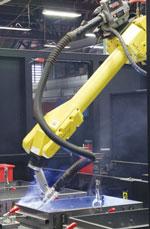
With knowledge of the dearth of welding experience in the local labor pool, Seconn Fabrication invested in a robotic welding cell to prepare for growth in its business.
"There's an energy here. It's contagious," Brax said.
"I've been involved in metal fabrication for 20 years, and I've never seen anything like it," said Jerry Elliott, Seconn Fabrication's sales manager.
Still Moving Forward
How do you maintain that culture with the growth? Marelli said he realizes that is the biggest hurdle his company will have to overcome as it continues to grow.
"It's hard to let go," he admitted, "but it's my responsibility to all of my workers to train, educate, mentor, and build that team."
Marelli has a clear-cut vision for Seconn Fabrication. He wants it to be the best shop in New England and reach $20 million in sales in the next five years.
He has a more personal goal as well. That goal is to establish a solid future for the employees who have worked hard to put Seconn Fabrication in the position to achieve so much in a relatively short time frame. He said he would like to see each Seconn Fabrication employee be put in a position where he or she could earn enough money to be the sole breadwinner for a family.
"I have to make my decisions for these men and women that believe in me. I need to keep this group together. That's my focus," Marelli said.
The same ol' same ol' was never in the plans for Seconn Fabrication. As a result, new and exciting opportunities lie ahead for this 5-year-old company with a lifetime of experience.
11 Steps to Speed up Production
Seconn Fabrication has proven adept at eliminating waste in its production processes. Most of the efforts have centered around getting parts out the door in the quickest way possible.
The company has committed to paying material suppliers in 20 days; as a result, the company can order sheet and expect delivery in one to two days. Also, the material suppliers provide cut-to-length services because of the prompt payment for services. Seconn Fabrication doesn't have to worry about stocking a shear to cut large sheet stock.

Seconn Fabrication's shop floor is arranged so that projects flow from raw material to the next natural step in the fabricating process until it's ready for final inspection, packaging, and shipping. In addition, notice the material shelving at the bottom right that is placed at an angle for easy access by lift trucks.
It can run lights-out on one of its laser cutting machines and turret punch presses. The TRUMPF L2510 laser cutting machine can process sheets with different thicknesses (up to 5/8 in. for mild steel, 1/4 in. for stainless steel, and 3/16 in. for aluminum) and is able to unload fully cut parts, without tabs, because of the unloading device's platform comprised of extended fingers. The 33-ton Amada Vipros III Z3510NT has a 56-station turret and automatic load and unload capabilities. It has been able to standardize 70 percent of the tooling in the turret by grouping jobs according to two size groups: 14 to 16 gauge and 18 to 20 gauge.
A grinding station is stationed right next to the TRUMPF L2510 to finish parts as they exit the laser cutter. That way parts aren't moved to another side of the factory for this required task. "We have a manufacturing guideline that parts don't leave here scratched or have burrs. It's taken care of here," said Paul Brax, a member of Seconn Fabrication's production team.
The company purchased a DCM industrial rotary grinder for sharpening punching tools. The new grinder is much quicker than manual grinding, which took operators away from their machines for much longer periods of time.
Pallet jacks are located throughout the factory in designated spots. Because the facility is organized according to a grid system, with each grid marked by a number, employees know that a pallet can be found within a few steps of the grid in which they are working.
The Amada HDS-1303NT press brake has a 10-foot bed with 143-ton capacity, but it also features touchscreen control with 3-D graphics to assist less experienced operators with part presentation and sequencing of bends. "With the labor pool the way it is, the machine has to do a lot of teaching," said Richard Sweet, Seconn Fabrication's production manager.
Welders used to spend 15 minutes changing out gas cylinders at one of the eight welding stations. Now the company has an on-site bulk container administered by ABCO, it industrial gas supplier.
Welders also do all of their own grinding, unless the job is considered large enough to warrant a full-time assist. Sweet said that welders have the best grinding skills, and the two production steps can be completed in a very short time frame because of the proximity.
A new welding cell from Lincoln Electric, complete with a PowerWave 455/STT® power source and a FANUC ArcMate robot, assists on some of the more weld-intensive jobs that would occupy a lot of a welder's time. For instance, one high-volume job for an electrical enclosure box that calls for joining clips and hinges in addition to welding four corners takes a welder four minutes to complete, but only 17 seconds for the robot.
All of the departments are organized according to fabrication flow. Raw material enters one door and flows through some or all of the other departments—cutting, bending, welding, machining, powder coating, silk screening, inspection, and packaging—until it's shipped out. Seconn Fabrication has five delivery trucks in its fleet and has an open account with a local truck leasing company to keep up with its approximately 20 shipments per day. "Nothing sits on the floor," Sweet said. "Deliveries on time are more important than full truckloads."
A new Yellowjacket stretch-wrap machine, purchased a year ago, has helped reduce the cost of wrapping a pallet from $7.50 to $2.50 and freed up labor. Now one person in a lift truck can raise the pallet up and down to ensure a full wrapping while the machine applies the stretch wrap. When the process was manual, two people wrapped the pallet, and a lift truck driver assisted by moving the pallet.

"I really think that we had a clean slate where we could set up our operations and culture the way we wanted to in the beginning. It made a significant difference." --Rob Marelli, Seconn Fabrication
Future investments will follow the same game plan. A new Prima Syncrono laser cutting system with a 10-pallet material tower will replace an older, stand-alone TRUMPF laser that will be moved to the new prototyping department. A new powder coating line, with 14 automated guns, will accentuate the current line with two manual ITW Gema guns. In fact, the new powder coating line with its five-stage washer will allow Seconn Fabrication to powder-coat freshly laser-cut parts, bypassing the need to have the oxidized edges grinded off them. The company also will be adding an Amada HDS-8025NT press brake.
Philanthropic Ideals
Seconn Fabrication isn't keeping the rewards associated with its success to itself. It has actively shared the wealth with the community.
The company annually donates between $25,000 and $40,000 to local athletic, health, and school programs and international efforts, such as Smile Train, a program for children with facial deformities. It also has worked with local vocational schools to establish an internship program that feeds young workers into the company and entertains students and community members at open house events and plant tours.
Struck by the demand for monetary and inkind donations, Seconn Fabrication President Rob Marelli plans to set up the Seconn Foundation, a 501 (c) 3 organization that formally addresses the many requests. Also, staff time and resources provided to the foundation would be tax-deductible, as would all Seconn Fabrication funds given to the new foundation.
With the new foundation comes a new mission for donations. According to Marelli, the foundation will look to reward organizations that develop new ways to solve existing problems. The foundation will not fund ongoing programs or operational dollars because it wants to influence "meaningful" change, he said. As an example, he pointed to a group that might be looking to establish a Web site for teaching English-as-a-second-language (ESL) classes, rather than a group looking to fund traditional ESL classroom programs that don't efficiently reach the masses needing language tutoring.
"Bottom line, if Seconn Fabrication maintained status quo, it would not be the organization it is today," Marelli said. "The Seconn Foundation seeks to impact the regional community in the same way."
Determining the Award Winner
Entrants to The FABRICATOR'sIndustry Award competition were asked to supply details about their company's operational improvements, impact on the marketplace, and contributions to the community.
Regarding operational improvements, judges wanted to know about approaches to shop floor organization, which could entail implementation of lean techniques, reduction of inventory, or increasing machine uptime; safety activities, which covered successes in reducing time lost to injury and establishing safety programs; and training efforts.
When it came to marketplace successes, judges looked for details on new business growth in current markets, new industries, and new regions; examples of customer satisfaction, such as on-time delivery rates and customer feedback; and the introduction of new products or value-added services.
Community involvement was also important. Judges looked for examples of how entrants support the effort to position manufacturing as a career choice. How do companies work with nearby educational institutions and reach out to young people? What sort of general community activities do the companies support?
The winner was determined using a 100-point scale. A maximum of 40 points could be awarded for operational improvements, 40 points for marketplace successes, and 20 points for community involvement. Judges included members of the Fabricators & Manufacturers Association board of directors and staff.
For winning the 2008 Industry Award, Seconn Fabrication won complimentary registration, travel, and hotel accommodations to FMA's Metal Matters 2008 educational event at Walt Disney World's Contemporary Resort in Lake Buena Vista, Fla., March 12-14, and special coverage in The FABRICATOR.
For those interested in entering the contest for the 2009 Industry Award, visit www.fmanet.org/Industry Award/Industry-Award.cfmfor more details.
About the Author

Dan Davis
2135 Point Blvd.
Elgin, IL 60123
815-227-8281
Dan Davis is editor-in-chief of The Fabricator, the industry's most widely circulated metal fabricating magazine, and its sister publications, The Tube & Pipe Journal and The Welder. He has been with the publications since April 2002.
subscribe now

The Fabricator is North America's leading magazine for the metal forming and fabricating industry. The magazine delivers the news, technical articles, and case histories that enable fabricators to do their jobs more efficiently. The Fabricator has served the industry since 1970.
start your free subscription- Stay connected from anywhere

Easily access valuable industry resources now with full access to the digital edition of The Fabricator.

Easily access valuable industry resources now with full access to the digital edition of The Welder.

Easily access valuable industry resources now with full access to the digital edition of The Tube and Pipe Journal.
- Podcasting
- Podcast:
- The Fabricator Podcast
- Published:
- 04/16/2024
- Running Time:
- 63:29
In this episode of The Fabricator Podcast, Caleb Chamberlain, co-founder and CEO of OSH Cut, discusses his company’s...
- Industry Events
16th Annual Safety Conference
- April 30 - May 1, 2024
- Elgin,
Pipe and Tube Conference
- May 21 - 22, 2024
- Omaha, NE
World-Class Roll Forming Workshop
- June 5 - 6, 2024
- Louisville, KY
Advanced Laser Application Workshop
- June 25 - 27, 2024
- Novi, MI
























